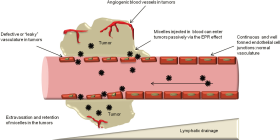Medicine:Enhanced permeability and retention effect
The enhanced permeability and retention (EPR) effect is a controversial concept[1][2] by which molecules of certain sizes (typically liposomes, nanoparticles, and macromolecular drugs) tend to accumulate in tumor tissue much more than they do in normal tissues.[3][4][5] The general explanation that is given for this phenomenon is that, in order for tumor cells to grow quickly, they must stimulate the production of blood vessels. VEGF and other growth factors are involved in cancer angiogenesis. Tumor cell aggregates as small as 150–200 μm, start to become dependent on blood supply carried out by neovasculature for their nutritional and oxygen supply. These newly formed tumor vessels are usually abnormal in form and architecture. They are poorly aligned defective endothelial cells with wide fenestrations, lacking a smooth muscle layer, or innervation with a wider lumen, and impaired functional receptors for angiotensin II. Furthermore, tumor tissues usually lack effective lymphatic drainage. All of these factors lead to abnormal molecular and fluid transport dynamics, especially for macromolecular drugs. This phenomenon is referred to as the "enhanced permeability and retention (EPR) effect" of macromolecules and lipids in solid tumors. The EPR effect is further enhanced by many pathophysiological factors involved in enhancement of the extravasation of macromolecules in solid tumor tissues. For instance, bradykinin, nitric oxide / peroxynitrite, prostaglandins, vascular permeability factor (also known as vascular endothelial growth factor VEGF), tumor necrosis factor and others. One factor that leads to the increased retention is the lack of lymphatics around the tumor region which would filter out such particles under normal conditions.
The EPR effect is usually employed to describe nanoparticle and liposome delivery to cancer tissue.[6] One of many examples is the work regarding thermal ablation with gold nanoparticles. Halas, West and coworkers have shown a possible complement to radiation and chemotherapy in cancer therapy, wherein once nanoparticles are at the cancer site they can be heated up in response to a skin penetrating near IR laser (Photothermal effect). This therapy has shown to work best in conjunction with chemotherapeutics or other cancer therapies.[7] Although the EPR effect has been postulated to carry the nanoparticles and spread inside the cancer tissue, only a small percentage (0.7% median) of the total administered nanoparticle dose is usually able to reach a solid tumor.[8]
See also
- Hiroshi Maeda (chemist)
References
- ↑ Nichols, Joseph W.; Bae, You Han (September 2014). "EPR: Evidence and fallacy". Journal of Controlled Release 190: 451–464. doi:10.1016/j.jconrel.2014.03.057. PMID 24794900.
- ↑ Danhier, F. (December 2016). "To exploit the tumor microenvironment: Since the EPR effect fails in the clinic, what is the future of nanomedicine?". Journal of Controlled Release 244 (Pt A): 108–121. doi:10.1016/j.jconrel.2016.11.015. PMID 27871992.
- ↑ "A new concept for macromolecular therapeutics in cancer chemotherapy: mechanism of tumoritropic accumulation of proteins and the antitumor agent smancs". Cancer Research 46 (12 Pt 1): 6387–92. December 1986. PMID 2946403. http://cancerres.aacrjournals.org/cgi/pmidlookup?view=long&pmid=2946403.
- ↑ Duncan, R.; Sat Y.-N. (1998). "Tumour targeting by enhanced permeability and retention (EPR) effect". Ann. Oncol. 9 (Suppl.2): 39.[verification needed]
- ↑ "Phase I clinical and pharmacokinetic study of PK1 [N-(2-hydroxypropyl)methacrylamide copolymer doxorubicin]: first member of a new class of chemotherapeutic agents-drug-polymer conjugates. Cancer Research Campaign Phase I/II Committee". Clinical Cancer Research 5 (1): 83–94. January 1999. PMID 9918206. http://clincancerres.aacrjournals.org/cgi/pmidlookup?view=long&pmid=9918206.
- ↑ Maeda H (2012). "Macromolecular therapeutics in cancer treatment: the EPR effect and beyond". J Control Release 164 (2): 138–44. doi:10.1016/j.jconrel.2012.04.038. PMID 22595146.
- ↑ "Lyso-thermosensitive liposomal doxorubicin: a novel approach to enhance efficacy of thermal ablation of liver cancer". Expert Opinion on Pharmacotherapy 10 (2): 333–43. February 2009. doi:10.1517/14656560802677874. PMID 19236203.
- ↑ "Analysis of nanoparticle delivery to tumours". Nature Reviews Materials 1 (5): 16014. April 2016. doi:10.1038/natrevmats.2016.14. Bibcode: 2016NatRM...116014W.
 |


